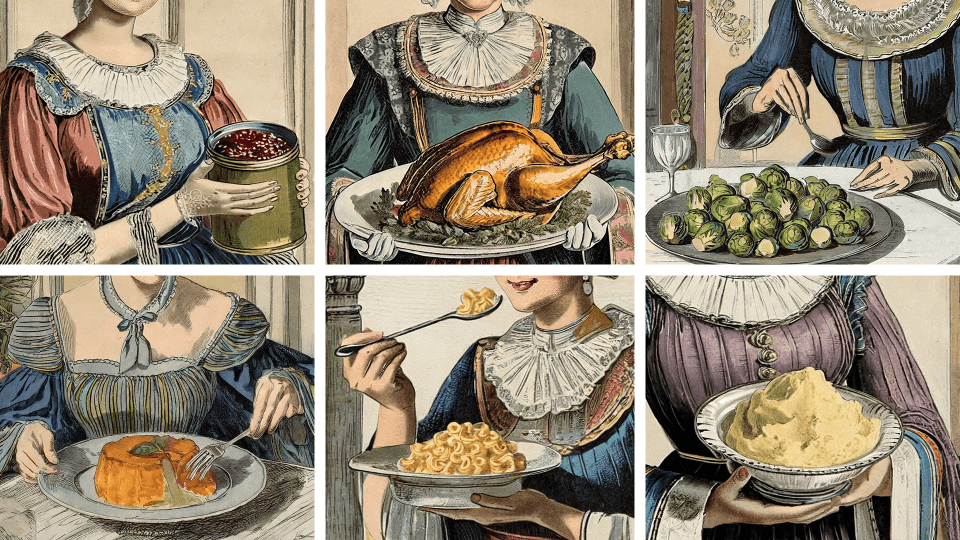How One Influential Woman Made Thanksgiving an American Tradition
November 14, 2023
- Contact
- Jay Pfeifer

Thanksgiving evolved into a tradition to showcase American ideals to the outside world. What better way to demonstrate Americans’ rural simplicity than a nationwide, rustic feast? Images generated using Adobe Firefly.
What most Americans think of as Thanksgiving started not in the 1620s but in the pages of a 19th-century women’s magazine.
Sarah Hale, an editor of Godey's Lady's Book and Magazine, used her influence to transform Thanksgiving from an irregular, austere harvest celebration to today’s annual family-centric feast.
According to Religious Studies Chair and Professor Anne Blue Wills, Hale saw the holiday as a way to unite America in a celebration of domesticity and simplicity.
“Hale understood that a nation, a community, needs a festival, a symbolic event to renew people, and remind them of their values,” Wills said.
Hale’s decades-long campaign was so successful that in 1863, President Abraham Lincoln declared the fourth Thursday of November a national holiday.
(Hale not only pushed Thanksgiving into the American consciousness, she is credited as the creator of the nursery rhyme “Mary Had A Little Lamb,” publishing the original in 1830.)
What was Thanksgiving like before Sarah Hale’s vision became so popular?
Before Hale’s campaign, Thanksgiving was not a ritualized holiday. It was an occasional event for the Pilgrims declared as needed by clergy to thank God for good fortune. Puritans emphasized that one should never presume on the will of God, so they never would have scheduled Thanksgivings.
What we now recognize as “the first Thanksgiving,” was simply an occasion for the Pilgrims to express their thanks to God for allowing them enough food to survive the winter.
In fact, true to Puritan character, the Pilgrims would not have spent all day feasting. Instead, they would have spent it in church, contemplating the mercies of God’s covenantal love.
How did Hale have the platform to will a holiday into existence?
Hale edited the leading women’s magazine Godey’s Lady’s Book for 50 years, from 1827 to 1877. The magazine’s circulation peaked in 1860 at 150,000 per month, which gave Hale tremendous access and influence to achieve her dream.
From the beginning, she was a crusader, using her magazine to promote causes like women’s education, and to raise a monument to honor those who fought and died at Bunker Hill. Thanksgiving was another of her big concerns.
So, what did Hale see in this nascent day of celebration?
Hale was concerned by increasing factionalism in American society and envisioned Thanksgiving as a commonly-celebrated, patriotic holiday that would unite Americans in purpose and values. She viewed those values as rooted in domesticity and rural simplicity over urban sophistication.
How did she use the magazine to popularize the idea of a Thanksgiving holiday?
Every November, Hale would focus her monthly column on Thanksgiving, positioning the celebration as a pious, patriotic holiday that lived on in the memory as a check against temptation, or as a comfort in times of trial. Hale and Godey’s led the way in creating a standardized celebration, which in turn created a standardized celebrant — a standardized and true American.
Her vision aimed at a broad audience: The stories in Godey’s depicted Black servants, Roman Catholics, and Southerners celebrating Thanksgiving, and becoming more American (which for Hale meant becoming more like White Protestant Northerners) by doing so.
Her Thanksgiving also showcased American values to the outside world. It demonstrated to Europeans, whom she considered decadent and urbanized, the U.S.’s national traits of piety, attachment to the land, recognition of heritage, and dedication to hard work.
How did the notion go from a magazine column to a national holiday?
Hale began calling on the President and Congress to declare Thanksgiving a nation-wide event, and she pushed harder and harder each year as the rift between the North and South became more threatening to the national unity she cherished.
She urged readers to lobby their representatives, and to write to her about their Thanksgiving experiences. They did, and Hale kept count each year of the growing number of celebrants in the U.S. and around the world.
Why did Hale think Thursday was a good day for a celebration?
Hale selected Thursday for the celebration because it gave women time to prepare a substantial meal for the holiday, and enough time afterward to prepare the traditional Sunday meal.
One difference between today’s Thanksgiving and Hale’s is that she never associated turkey with the holiday, favoring chicken and oysters instead.
She pushed Thanksgiving for five decades. How did the celebration itself change over that time?
As the century unfolded and transportation improved, the wider variety of foods available was showcased in the magazine’s Thanksgiving meals, and stories discussed the type of clothing and decorations appropriate for the holiday.
A version of this article first appeared on davidson.edu in 2012.


